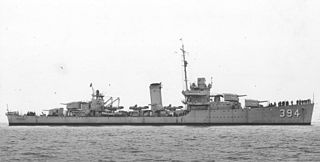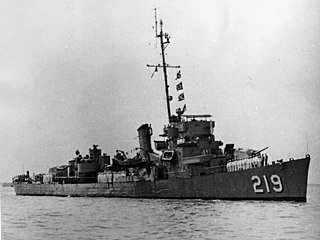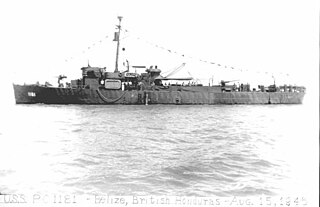
USS Sawfish (SS-276), a Gato-class submarine, was a ship of the United States Navy named for the sawfish, a viviparous ray which has a long flat snout with a row of toothlike structures along each edge. It is found principally in the mouths of tropical American and African rivers.

USS Blenny (SS/AGSS-324), a Balao-class submarine in commission from 1944 to 1969, was a ship of the United States Navy named for the blenny, a fish found along the rocky shores of the Atlantic Ocean. During World War II, Blenny conducted four war patrols in the Java Sea and South China Sea between 10 November 1944 and 14 August 1945. She sank eight Japanese vessels totaling 18,262 tons. In addition, she is credited with destroying more than 62 miscellaneous Japanese small craft by gunfire.

USS Bumper (SS-333), a Balao-class submarine, was a ship of the United States Navy named for the bumper, a small fish of the North and South Atlantic Ocean.

USS Acree (DE-167) was a Cannon-class destroyer escort in service the United States Navy from 1943 to 1946. She was scrapped in 1973.

USS Sicard (DD-346/DM-21/AG-100) was a United States Navy Clemson-class destroyer in commission from 1920 to 1945. She was service during World War II. She was named for Rear Admiral Montgomery Sicard.

The second USS Sampson (DD-394) was a Somers-class destroyer in the United States Navy. She was named of William Thomas Sampson a rear admiral known for his victory in the Battle of Santiago de Cuba during the Spanish–American War.
USS PC-1136 was a PC-461-class submarine chaser built for the United States Navy during World War II. Shortly after the end of the war, she was renamed USS PCC-1136 when she was reclassified as a combat communications control ship. In 1956, she was renamed Galena (PC-1136), becoming the third U.S. Navy vessel so named, but never saw active service under that name.
USS PC-1137 was a PC-461-class submarine chaser built for the United States Navy during World War II. After World War II, the ship was renamed USS PCC-1137, reflecting her new role as a combat communications control ship. Later, in 1956, she was renamed Worthington (PC-1137) although she never saw active service under this name.

USS J. Douglas Blackwood (DE-219), was a Buckley-class destroyer escort in service with the United States Navy from 1943 to 1946 and from 1951 to 1961. She was sunk as a target in 1970.
USS PC-1141 was a PC-461-class submarine chaser built for the United States Navy during World War II. She was renamed USS Pierre (PC-1141) in 1956, was decommissioned from the U.S. Navy in October 1958, and transferred to the Indonesian Navy as KRI Tjakalang.
USS Adroit (AM-82/PC-1586) was an Adroit-class minesweeper acquired by the United States Navy for the task of removing mines that had been placed in the water to prevent the safe passage of ships.
USS Annoy (AM-84) was an Adroit-class minesweeper of the United States Navy. She was laid down on 3 December 1941 at Portland, Oregon, by the Commercial Iron Works; launched on 6 April 1942; and commissioned on 2 September 1942. In 1944 she was reclassified as a patrol craft and renamed PC-1588.
USS PC-465 was a PC-461-class submarine chaser built for the United States Navy during World War II. She was later renamed Paragould (PC-465) but never saw active service under that name. In 1961 she was transferred to the Venezuelan Navy under the name ARV Pulpo (P-7). She remained active in Venezuelan service until 1968, when she was placed in reserve. She was stricken in 1978 but her ultimate fate is unknown.

USS Rinehart (DE-196) was a Cannon-class destroyer escort built for the United States Navy during World War II. She served in the Atlantic Ocean and Pacific Ocean and provided escort service against submarine and air attack for Navy vessels and convoys. The ship entered the reserves after the end of the war, and in 1950 was transferred to the Royal Netherlands Navy, where she served under the name De Bitter until 1967. She was sold for scrap in 1968.

USS Tomich (DE-242) was an Edsall-class destroyer escort in service with the United States Navy from 1943 to 1946. She was scrapped in 1974.
USS PC-1129 was a PC-461-class submarine chaser built for the United States Navy during World War II. She was sunk by a Japanese suicide boat in January 1945 in the South China Sea.
USS PC-817 was a PC-461-class submarine chaser built for the United States Navy during World War II. She was later renamed Welch (PC-817) but never saw active service under that name.
USS PC-1145, later USS Winnemucca (PC-1145), was a United States Navy PC-461-class submarine chaser in commission from 1944 to 1955. In 1960, she was transferred to South Korea for service in the Republic of Korea Navy.

USS PC-1181 was a PC-461-class submarine chaser built for the United States Navy during World War II. She was later renamed Wildwood (PC-1181) but never saw active service under that name.
USS Arcata (PC-601) was a United States Navy PC-461-class submarine chaser named for Arcata, California; the second Navy ship to carry the name.









